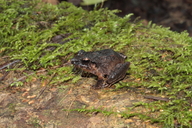|
Craugastor loki (Shannon & Werler, 1955)
Common Leaf-Litter Frog, Volcán San Martín Robber Frog Subgenus: Craugastor | family: Craugastoridae genus: Craugastor |
| Species Description: Shannon, F. A., and J. E. Werler. 1955. Notes on amphibians of the Los Tuxtlas range of Veracruz, Mexico. Transactions of the Kansas Academy of Science 58, 360–386. | |
|
Taxonomic Notes: Lynch, J.D. (2000). The relationships of an ensemble of Guatemalan and Mexican frogs (Eleutherodactylus: Leptodactylidae: Amphibia). Revista de la Academia Colombiana de Ciencias Exactas, Físicas y Naturales 24, 129–156. |
|
|
Etymology: Craugastor loki is named after the Teutonic god of strife and fire, which is a reference to the two color pattern characteristics that can be used to distinguish it from congeners (Shannon and Werler 1955); however, these traits seem to be regionally restricted to southern Veracruz (Streicher et al. 2014). |
|
 © 2013 Sean Michael Rovito (1 of 10) |
|
|
|
Description Craugastor loki can typically be differentiated from the other two species of the C. rhodopis Species Group as follows (character condition in parentheses): Unlike C. occidentalis, C. loki has a small supratympanic fold that is often subtended by two tubercles that are occasionally fused (‘Y-shaped’ supratympanic fold that extends onto the lateral surfaces of the flanks). Unlike C. rhodopis, C. loki has a relatively short shank rarely exceeding 54% of the snout-vent length (relatively long shank up to 65% of the snout-vent length). In general, this species possesses a more uniformly colored dorsum than most C. rhodopis Species Group taxa; however, some individuals from Guatemala possess mottled dorsum (Streicher et al. 2014). Most individuals of C. loki possess distinctive black canthus rostalis and supratympanic masks. Dorsal ground color can be orange, tan, brown or almost cream white. The dorsum is covered by many small glands (substantially smaller than those observed in C. occidentalis) and many individuals have faint linear ridging that runs the length of the dorsum. Some individuals have a thin mid-dorsal pinstripe. Some individuals from populations in southern Veracruz, Mexico (and the holotype, a female) have a white subocular patch (Shannon and Werler, 1955; Streicher et al. 2014). Distribution and Habitat Country distribution from AmphibiaWeb's database: Belize, Guatemala, Honduras, Mexico
Life History, Abundance, Activity, and Special Behaviors Craugastor loki calls almost continuously throughout the year (Figueroa-Huitrón et al. 2020). Calling starts in early April, likely coinciding with the arrival of the wet season, and continues until November and December (Gottsberger and Gruber 2004). Larva Trends and Threats Relation to Humans Comments The original description of Craugastor loki (named after the Teutonic god of strife and fire) used two color pattern characteristics to distinguish it from congeners (Shannon and Werler 1955); however, these traits seem to be regionally restricted to southern Veracruz. Several populations of C. loki were previously referred to as C. rhodopis (Streicher et al. 2014). References Gottsberger, B. and Gruber, E. (2004). Temporal partitioning of reproductive activity in a neotropical anuran community. Journal of Tropical Ecology, 20(3), 271–280. [link] IUCN SSC Amphibian Specialist Group. 2020. Craugastor loki. The IUCN Red List of Threatened Species 2020: e.T56726A53965108. https://dx.doi.org/10.2305/IUCN.UK.2020-1.RLTS.T56726A53965108.en. Accessed on 28 November 2023. Javier-Vázquez E., Luna-Reyes, R. and Moreno-Ovando, A. (2022). Amphibian diversity and conservation in the Ejido Tierra y Libertad, southwestern Chiapas, Mexico. Herpetological Conservation and Biology 17(3), 451-466. [link] Lynch, J.D. (2000). The relationships of an ensemble of Guatemalan and Mexican frogs (Eleutherodactylus: Leptodactylidae: Amphibia). Revista de la Academia Colombiana de Ciencias Exactas, Físicas y Naturales 24, 129–156.[link] Shannon, F.A. and Werler, J.E. (1955). Notes on amphibians of the Los Tuxtlas range of Veracruz. Transactions of the Kansas Academy of Sciences 58(3), 360–386. [link] Streicher, J.W., García-Vázquez , U.O., Ponce-Campos, P., Flores-Villela, O., Campbell, J.A. and Smith, E.N. (2014) Evolutionary relationships amongst polymorphic direct-developing frogs in the Craugastor rhodopis species group (Anura: Craugastoridae). Systematics and Biodiversity 12(1), 1–22. [link] Originally submitted by: Jeffrey W. Streicher (2023-12-12) Description by: Jeffrey W. Streicher (updated 2023-12-12)
Distribution by: Jeffrey W. Streicher (updated 2023-12-12)
Life history by: Jeffrey W. Streicher (updated 2023-12-12)
Larva by: Jeffrey W. Streicher (updated 2023-12-12)
Trends and threats by: Jeffrey W. Streicher (updated 2023-12-12)
Relation to humans by: Jeffrey W. Streicher (updated 2023-12-12)
Comments by: Jeffrey W. Streicher, Ann T. Chang (updated 2023-12-12)
Edited by: Ann T. Chang (2024-08-22) Species Account Citation: AmphibiaWeb 2024 Craugastor loki: Common Leaf-Litter Frog <https://amphibiaweb.org/species/6604> University of California, Berkeley, CA, USA. Accessed Jun 15, 2025.
Feedback or comments about this page.
Citation: AmphibiaWeb. 2025. <https://amphibiaweb.org> University of California, Berkeley, CA, USA. Accessed 15 Jun 2025. AmphibiaWeb's policy on data use. |




 Map of Life
Map of Life